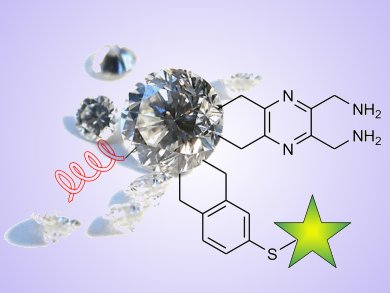Unreactive Material
Gilding the lily is a pointless exercise, but how about giving diamonds a new coating? Chemists in Germany have now demonstrated that it is possible to functionalize the surface of nanoscopic diamonds using the Diels-Alder reaction. The process could open up a whole range of applications in drug discovery, the researchers say, as well as offering a new approach to formulating drug-delivery agents.
Diamond has long been thought of as a relatively unreactive material because the stable network of valency-fulfilled carbon atoms from which it is composed are essentially locked away from reactants. As such, applications were mainly based on its aesthetic qualities for jewelry or its well-known mechanical resistance and remarkable optical properties. Its hardness makes it useful for cutting tools and drill bits while its thermal conductivity has been exploited in computer chip cooling.
If there were a simple and effective way to functionalize a diamond surface then many more applications could become accessible to materials scientists, pharmaceutical researchers, engineers and optoelectronics developers.
New Phase of Discovery
Gerald Jarre, Yuejiang Liang, Patrick Betz, Daniel Lang and Anke Krueger of the Institute for Organic Chemistry at the Julius-Maximilians-University in Würzburg, Germany, point out that as vapor-deposited thin films or in nanoparticulate form, diamond has already shown great potential in sensing applications, electrochemistry, fluorescence labeling, magnetic sensing and drug delivery. However, conventional chemical reactions adapted to this new phase of discovery could open up many more possibilities. As such, the team has now turned to the well known cyclization reaction, the Diels-Alder reaction, to covalently bond aromatic groups to the surface of nanoscale pieces of diamond.
There have been a few reactions of the diamond surface investigated previously. For instance, direct C–C coupling with a suitable organic reagent has been achieved, arylation of diamond nanoparticles using diazonium salts followed by Suzuki coupling is possible, as are radical reactions for alkylation. The Diels-Alder reaction offers a novel approach involving the grafting of o-quinodimethanes on to a thermally annealed nanodiamond surface.
Changing Surface Reactivity
The team investigated the results of different annealing conditions using X-ray diffraction (XRD) and high-resolution transmission electron microscopy (HRTEM) to show that the diamond surface was not converted to a graphitic state during the process and to demonstrate that the diamond core is afterwards intact. The annealing does, however, significantly change the reactivity of the diamond surface towards the dienes used in Diels-Alder reactions by forming a coating of pi bonds. The o-quinodimethanes are generated in situ, the team explains, which undergo Diels-Alder with the surface to produce the requisite benzene rings bonded to the diamond surface through two methylene bridges. The team tested their approach using different kinds of o-quinodimethanes to show that not only is the method efficient but has general application.
The researchers also demonstrated that the modified surface can be further functionalized through additional reaction of the aromatic groups. They have, for instance added a fluorescent dye molecule to the modified diamond surface and were able to purify the product using conventional column chromatography. The next stage in the work will be to graft biologically active compounds on to nanodiamonds as such conjugates would be of interest in drug discovery and drug delivery, for example.
Reactive Graphitic Coating?
Loh Kian Ping of the National University Of Singapore has also worked on functionalizing diamond surfaces and points out that the Diels-Alder reaction has previously been demonstrated on graphene, carbon nanotubes and other novel carbon allotropes.
“We do not need this reaction specifically to open up new coupling, as conventional carboimide chemistry is easier to do,” he says. “Also for the Diels-Alder reaction to take place, it means the surface must have pi bonds. Somehow these involve the reconstruction of the diamond to be more sp2-like,” he adds. “That may not be a problem since most nanodiamond surfaces have a graphitic coating, it may be that the chemistry is occurring on the thin graphitic coating on diamond.”
- Playing the surface game Diels-Alder reactions on diamond nanoparticles
G. Jarre, Y. Liang, P. Betz, D. Lang, A. Krueger,
Chem. Commun. 2011, 47.
DOI: 10.1039/C0CC02931A




